Excerpts from Jim Conrad's
Naturalist Newsletter
Entry dated March 8, 2024, from notes taken about 2kms south of Higuerillas, Municipality of Cadereyta de Montes; N20.8872°, W99.7718°, elevation ~1660 meters (~5450 feet); on alluvium of valley floor; local narrow belt of vegetation constituting an extreme southern extension of the Chihuahuan Desert, Meridional Subregion; central Querétaro state, MÉXICO
PSEUDOSMODINGIUM ANDRIEUXII
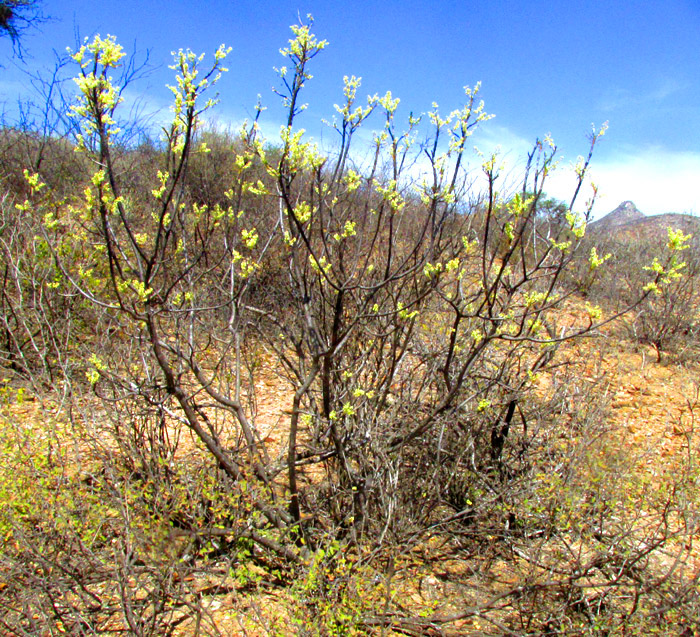
On the lower slope of a shallow valley's rock-strewn alluvial floor, the above shrub blossomed brightly in a landscape of drought-parched scrub where hardly anything else flowered, and only a few plants bore leaves. It was the only plant of its species I found during a week of wandering the area.
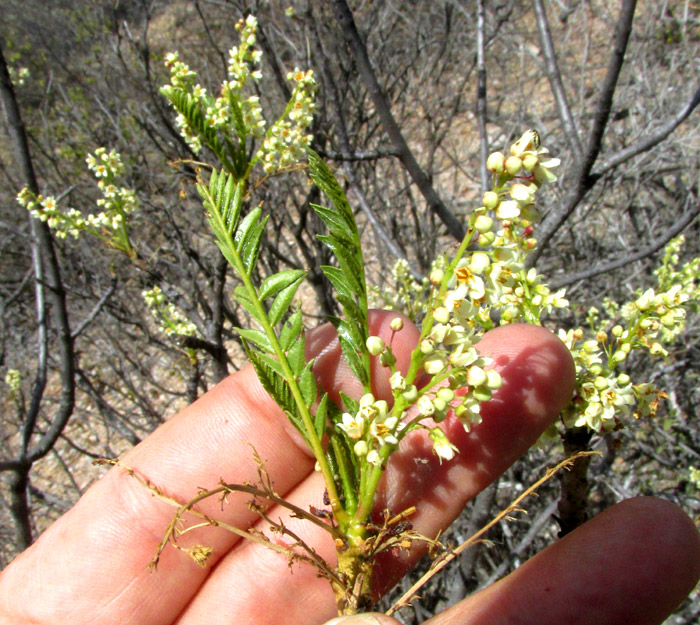
Most branch-tip inflorescences were unaccompanied by expanding leaves, but the above was. Panicle-type inflorescences bore raceme-type branches. Expanding leaves were once-pinnately divided. Below the inflorescences and expanding leaves, the dried-up remains of last season's fruiting clusters were retained.
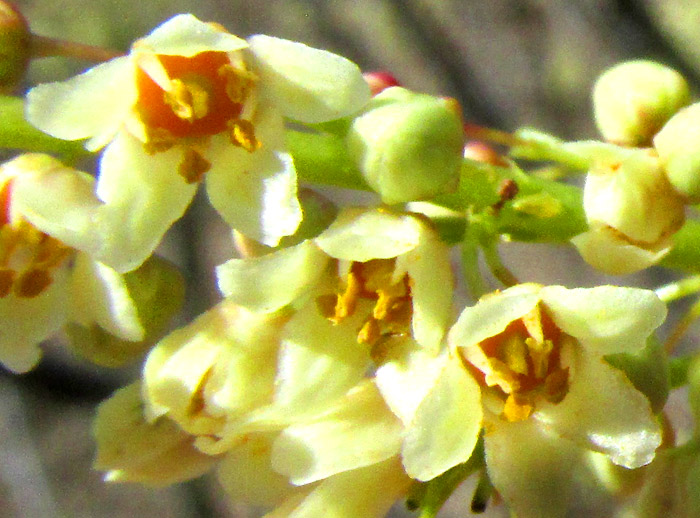
Flowers bore five petals alternating with five stamens, which was a very common arrangement among flowering plant families, but at the base of the short style in each flower's center there was a flattish, disc-like, orangish structure, the receptacle. In flowers, the receptacle is a thickened part of the flower's stem, or pedicel, from which other flower parts such as the petals and sepals grow. With such a receptacle, the above flowers were very similar to various members of the Cashew or Sumac Family, the Anacardiaceae. For example, check out the flower picture at the bottom of our Fragrant Sumac page.
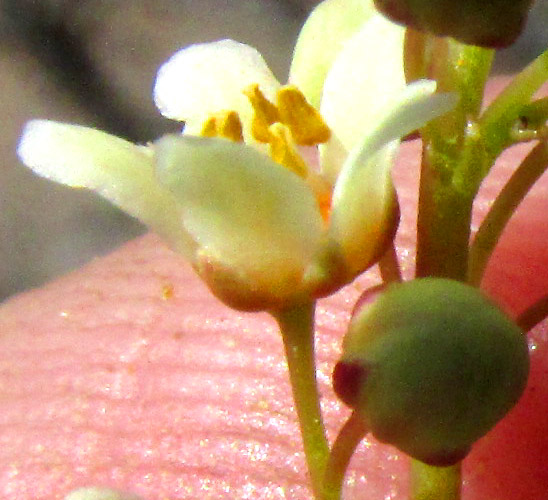
Above you can see how the stamens with their short, broad-based filaments bent over the receptacle, and the anthers narrowed at their tops. Below the flower, the slender pedicel enlarges at its top to form the receptacle.
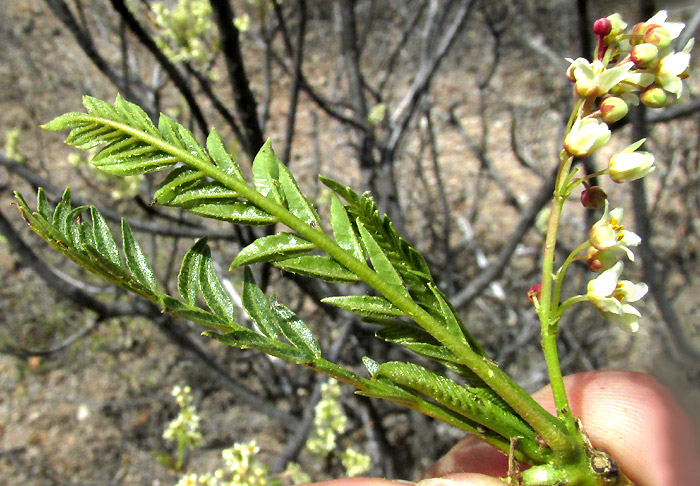
The pinnate leaves developed about 12 pairs of leaflets, with one leaflet terminating the rachis. Later it would be important to notice that the leaves bore no or very few hairs, and the leaflets were sharply tipped, not rounded, and they were widest below or at their middles.
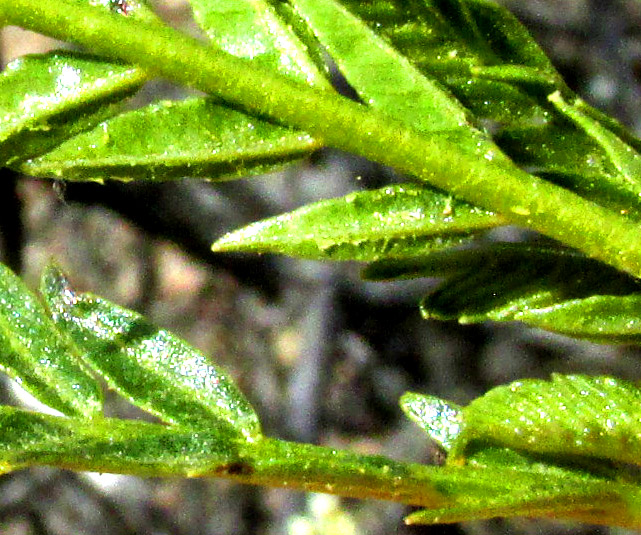
Leaflet surfaces were somewhat shiny and oily looking. Since the Cashew/Sumac Family is famous for its several members which cause dermatitis when touched, such as Poison Oak, I suspected that our bush might cause allergic reactions on me, but it didn't. The above photo shows widely scattered items which could be glands involved with producing toxic chemicals. In the 2004 work by Carlos Aguilar-Ortigoza and Victoria Sosa entitled "Taxonomic Revision of the Genus Pseudosmodingium (Anacardiaceae)," it's written that Pseudosmodingium andrieuxii "... is one of the most toxic species in the genus." Contact with leaves causes acute dermatitis. However, the 1999 volume of the Flora del Bajío by Jerzy and Graciela Rzedowski reports that the species is registered as a plant causing allergies, but that the reactions it causes usually aren't as severe as other species of Pseudosmodignium.
In the lower, left side of the above image, notice that greenish tissue of leaflet bases merges with low, narrow "wings" running atop the rachis. The wings, obscure as they are, are prime field marks for separating this species, which is PSEUDOSMODINGIUM ANDRIEUXII, from the earlier-mentioned, co-inhabiting P. virletii. Here's what our bush's much-branched base looked like:

Pseudosmodingium andrieuxii, with no English name, is endemic just to our part of central Mexico, south in dry scrub communities to Oaxaca state. This is a fairly limited distribution, though the Flora del Bajío considers it moderately abundant in its scrub habitat where it does occur.
Perhaps because of its allergenic properties, I find no use of this species as a traditional therapy, or for any other purpose. My experience with other members of the Cashew/Sumac Family, however, suggest that the flowers are much favored by insect pollinators.
How does a genus end up being named Pseudosmodingium? It's because it's similar to African Poison Ivy, Smodingium argutum. A 1963 article by G.H. Findlay entitled "Dermatitis of 'Poison Ivy' type from an Indigenous South African Plant -- Smodingium argutum E. Mey (Anacardiaceae)," writes that the name Smodingium "... appears to derive from the Greek, meaning an indurated mark. It refers to the hard fruit."